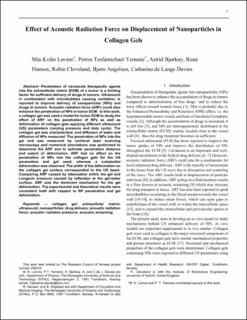| dc.contributor.author | Løvmo, Mia Kvåle | |
| dc.contributor.author | Yemane, Petros Tesfamichael | |
| dc.contributor.author | Bjørkøy, Astrid | |
| dc.contributor.author | Hansen, Rune | |
| dc.contributor.author | Cleveland, Robin O. | |
| dc.contributor.author | Angelsen, Bjørn Atle Johan | |
| dc.contributor.author | Davies, Catharina de Lange | |
| dc.date.accessioned | 2021-03-29T09:09:22Z | |
| dc.date.available | 2021-03-29T09:09:22Z | |
| dc.date.created | 2021-01-16T17:58:16Z | |
| dc.date.issued | 2020 | |
| dc.identifier.citation | IEEE Transactions on Ultrasonics, Ferroelectrics and Frequency Control. 2020, 68 (3), . | en_US |
| dc.identifier.issn | 0885-3010 | |
| dc.identifier.uri | https://hdl.handle.net/11250/2735896 | |
| dc.description.abstract | Penetration of nanoscale therapeutic agents into the extracellular matrix (ECM) of a tumor is a limiting factor for the sufficient delivery of drugs in tumors. Ultrasound (US) in combination with microbubbles causing cavitation is reported to improve delivery of nanoparticles (NPs) and drugs to tumors. Acoustic radiation force (ARF) could also enhance the penetration of NPs in tumor ECM. In this work, a collagen gel was used as a model for tumor ECM to study the effects of ARF on the penetration of NPs as well as the deformation of collagen gels applying different US parameters (varying pressure and duty cycle). The collagen gel was characterized, and the diffusion of water and NPs was measured. The penetration of NPs into the gel was measured by confocal laser scanning microscopy and numerical simulations were performed to determine the ARF and to estimate the penetration distance and extent of deformation. ARF had no effect on the penetration of NPs into the collagen gels for the US parameters and gel used, whereas a substantial deformation was observed. The width of the deformation on the collagen gel surface corresponded to the US beam. Comparing ARF caused by attenuation within the gel and Langevin pressure caused by reflection at the gel-water surface, ARF was the prevalent mechanism for the gel deformation. The experimental and theoretical results were consistent both with respect to the NP penetration and the gel deformation. | en_US |
| dc.language.iso | eng | en_US |
| dc.publisher | Institute of Electrical and Electronics Engineers (IEEE) | en_US |
| dc.title | Effect of acoustic radiation force on displacement of nanoparticles in collagen gels | en_US |
| dc.type | Peer reviewed | en_US |
| dc.type | Journal article | en_US |
| dc.description.version | acceptedVersion | en_US |
| dc.source.volume | 68 | en_US |
| dc.source.journal | IEEE Transactions on Ultrasonics, Ferroelectrics and Frequency Control | en_US |
| dc.source.issue | 3 | en_US |
| dc.identifier.doi | 10.1109/TUFFC.2020.3006762 | |
| dc.identifier.cristin | 1872550 | |
| dc.description.localcode | © 2020 IEEE. Personal use of this material is permitted. Permission from IEEE must be obtained for all other uses, in any current or future media, including reprinting/republishing this material for advertising or promotional purposes, creating new collective works, for resale or redistribution to servers or lists, or reuse of any copyrighted component of this work in other works. | en_US |
| cristin.ispublished | true | |
| cristin.fulltext | postprint | |
| cristin.qualitycode | 1 | |
